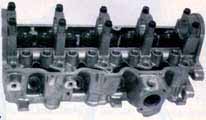
There are 2 basic 8 valve heads for the 2.2/2.5 family that we are interested in.
Gary's 2.2/2.5 cylinder head guide

There are 2 basic 8 valve
heads for the 2.2/2.5 family that we are interested in.
The first is the "bathtub"
chamber head used from 1983-1994. The second head is the "swirl"
chamber or "fastburn" head used from 1986-1994, It has a 6 cc smaller chamber.
|
1983-1984 2.2l |
Casting number 4105445 |
|
1985 2.2l |
Casting number 4323287 |
|
1986 2.2l fastburn |
Casting number 4105782 |
|
1986-1988 2.2 Turbo I |
Casting number 4105782 |
|
1986-1994 2.2 carb/TBI |
Casting number 4105445 |
|
1987-1990 2.2l Turbo II |
Casting number 4105782 |
|
1986-1994 2.5l TBI |
Casting number 4105782 |
|
1989-1992 2.5l Turbo |
Casting number 4105782 |
Now as you can see on this chart some heads were used for Turbo as well as NON-Turbo applications and would give you the impression that the heads are the same. This is true- to a point. All turbo heads come with stiffer valve springs and exhaust valves made of better materials. Using NON turbo exhaust valves in a turbo application will cause them to fail in a matter of months! Intake valves are the same between turbo and non-turbo applications.
There are a
few more curves to throw your way before we move on. All Turbo II &
2.5 Turbo heads are "crossdrilled" for better block cooling (the blocks
are crossdrilled as well to match) Later TBI engines have this feature
as well (91 and up?) I have had no problems mixing these heads with
normal blocks and vice versa. (The normal TII head gasket works fine for
this combination)
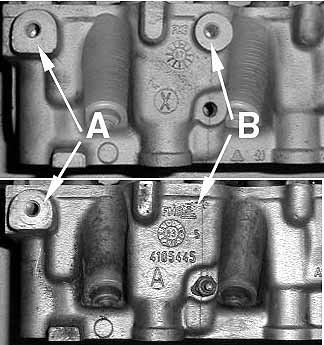
Here is another physical difference between different year cylinder heads. The lower head shows the typical A/C mounting boss used from 1981-1984 while the later model upper head has an extra boss in location B. You can use the early head on a later model car, just one of the bosses won't be there for the a/c bracket...
IMPORTANT CYLINDER HEAD CHANGES TO BE AWARE OF!
1) SWIRL PORT HEAD VALVES ARE TALLER THEN BATHTUB HEAD VALVES, DON'T MIX THEM!
Overall height of a 86-65 SWIRL head valve is 114 mm, 82-85 BATHTUB head valves are about 112 mm. Using a swirl head valve in a bathtub head will cause the the valves to stay open causing no compression.
2) Oversize journal cylinder heads
Mopar had a few screw ups in machining cylinder head cam journals. Rather then throw out these heads, they machined them out to an oversize journal size that requires a special oversize journal cam. Needless to say there are no performance cams available for these heads and you should avoid any head stamped "OSJ" on the drivers end of the head. Using a stock cam on this head will cause a massive loss in oil pressure!!! First indication that you have installed the wrong cam in the head will be the refusal of the lifters to pump up due to the massive internal oil pressure leakage..
3) Discontinuation of cam lobe lubricators in 89-90
Chrysler used slider cams in the 2.2 & 2.5 engines till 1988 when they started phasing in the roller cam shafts. For cam lobe lubrication purposes the cylinder head cam tower caps were machined for "oil squirters." These would shoot a splash of oil onto the cam lobe when an oiling slot machined into the cam journal lined up with the oil passage lubricating the journal and a channel in the cam tower. Early 88 roller cams still had the "lube slot" cut into them and was done away with by 1989. The roller cams needed much less lubrication then the slider cams! In late 1989 it appears Chrysler did away with the oil squirt passages on cam caps 2, 3 & 4 altogether! A slider cam on one of these cylinder heads would rapidly wear out I would imagine. Please inspect your 89+ casting before attempting to install a slider camshaft!
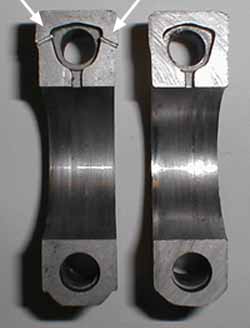
84-88 cap on left, 89-95 on right
You maybe
able to have the caps machined for the oil squirters, swapping caps from an
early head really isn't a viable option due to the fact the head would have to
be re-machined for the new caps.
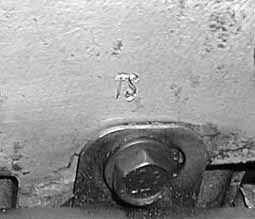
You may want to state that even though the casting numbers were the same (Turbo to TBI) the heads were different. As you probably already know, the turbos received the increased angle tapered shroud. This can be identified by the 'TS' stamped into the #4 end on the cylinder head. Running a non-TS head, on a turbo, can result in an increase in knock sensitivity (ouch!!). 5DIGITS
True- this could be a problem. (I haven't noticed it to be)
When you get
performance valve work done at a machine shop the valves get unshrouded
anyways making it a non-issue. Could be a problem with a non-modified
head but again I haven't seen any problems in the field....
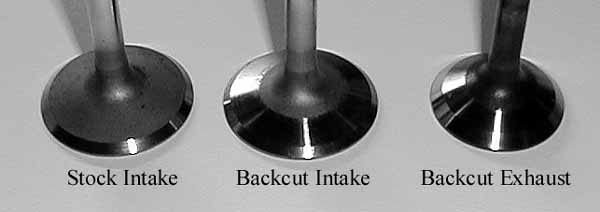
One little trick I have done to my Daytona was to have the valves backcut. This involves have material removed off the back of the valve head and improves the flow over and around the valve. With a stock fast burn head and backcut valves my Daytona has run 12.6@110 MPH with the engine making approximately 315 hp at 30 psi of boost.
The "magic" numbers
for the cuts are 20-21 degrees for the intake valve, 31-32 degrees for
the exhaust valves (which number you use wil depend on your valves face
cut)
The best flowing head is the 83-85 "445" & "287" casting head. It flows 10% more air than the 86-94 "782" head which makes about 10% more torque. The "G" head would be a good choice for a light car, while the "782" or "fast burn" head will be better for a heavier vehicle due to its better throttle response and higher port velocity.
Porting and polishing of cylinder heads is best done by a professional. Unless you have lots of practice and have done several, it's very easy to damage a head and make it unusable.
Mopar Performance has two heads in their catalog: a mild ported "445" head with 1 mm oversize valves, and a more extensively ported "445" head with much larger valves.
LRE, Forward
Motion and TAFT also have ported heads for sale.
Headgaskets
Without a doubt
the best headgasket money can buy for a 2.2 is the factory gasket from
Mopar, here is a list of the following part numbers from the MP Catalog.
|
P4452005 |
Carb and Turbo I |
|
P4452006 |
Turbo II & 2.5 Turbo I |
|
P4452007 |
O-ringed block |
|
P4452008 |
O-ringed and crossdrilled |
My opinion of Fel-Pro 2.2 headgaskets? THEY SUCK. I have seen them fail in as little as 3000 miles on a 2.2. When it comes to V8 engines Fel-Pro is the brand I reach for (they are on my GTX as a matter of fact) when it comes to 2.2 liters, reach for Mopar Performance.
Fel-Pro does make a nice copper shim marketed
as a "engine saver shim" for our engines if you are looking to drop your
compression a bit if you have had to much milled off.
NAPA also sells a engine saver shim (non
cross drilled engines only) part number is 3688S - manufactured by Dana
Victor.
Speaking of milling, .20-.30 milled off your head is equal to 2 degrees of retarded cam timing. Get offset cam keys to set it back (unless you want your cam timing retarded of course)
Need headbolts? Go Mopar as well, they cost less then Napa's or Fel-Pro's and work much better. 1983-1985 use 10mm headbolts and are torqued (in ft/lbs) 35-45-45-1/4 turn and 1986-1994 are 11mm and are torqued 45-65-65-1/4 turn
Plan on using ARP head studs? Before installing them make a slot at the top of the stud (I use a cut-off wheel) so a screwdriver can be used to install and remove them. This will be of great assistance the first time you have to do a headgasket in the car!
....these cars like efficiency of flow, not mass of flow on the heads...